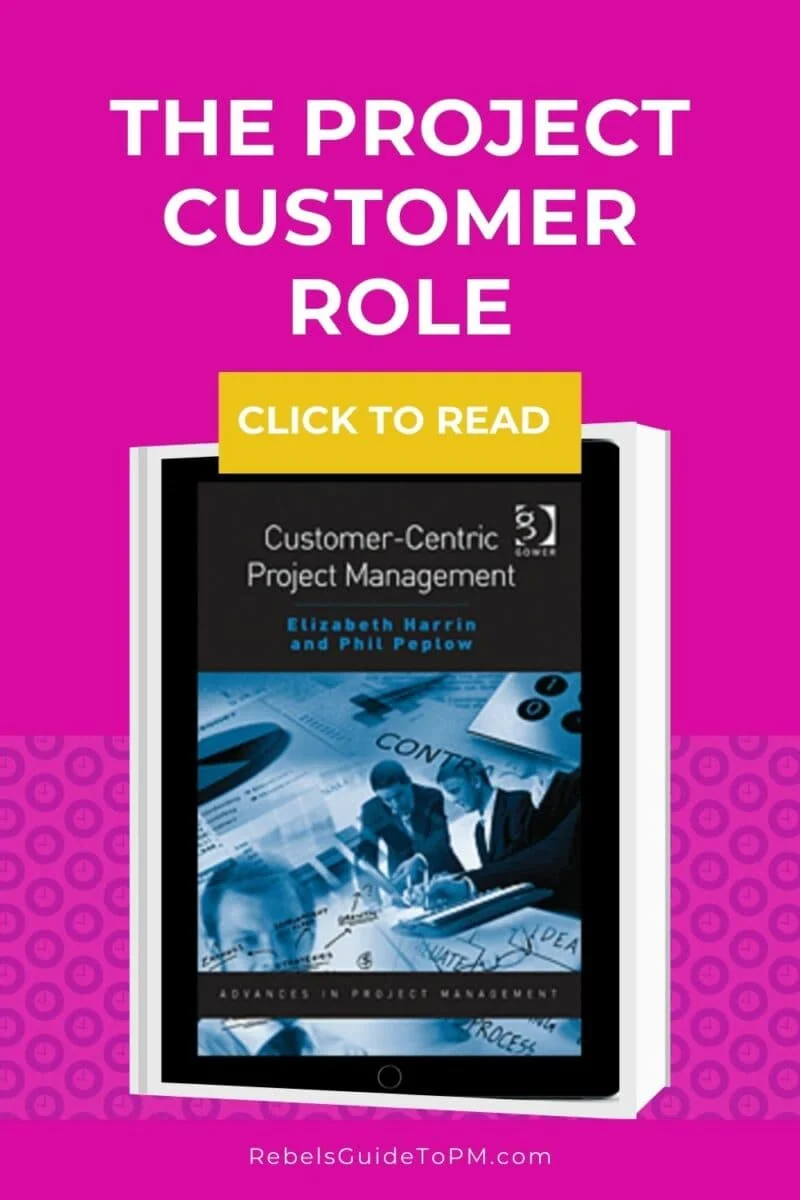The project customer role
This blog is reader-supported. When you purchase something through an affiliate link on this site, I may earn some coffee money. Thanks! Learn more.

This is an edited extract from my book Customer-Centric Project Management, co-authored with Phil Peplow (Routledge, 2012).
As any project manager will know, projects do not exist in a vacuum. They are created from the need to fulfil an organizational objective such as generating more revenue or improving brand awareness.
Projects happen because someone – an individual or a committee – deems that this particular initiative will deliver some kind of business benefit. Typically, the person who stands to gain the most value from a project becomes the project sponsor.
For example, the Sales Director would sponsor a project to install new customer management software, providing the sales team with more opportunities to cross-sell to the existing customer base. The sponsor receives the output from the project and wants to do something with it to achieve those organizational objectives.
Creating a successful project team involves ensuring excellent links between the ‘permanent’ project employees – those who work predominantly in a projectized way such as project managers and business analysts – and those who have joined a project team on a secondment basis as a subject matter expert or stakeholder.
Project teams are made up of wide groups of diverse professionals, and ensuring that stakeholders are engaged in the project process is essential to the success of the project. Close working relationships with the project customer and the end users they represent are important.
Satisfied customers make good allies in tough times.
Who is the project customer?
Project customers are those stakeholders with a significant vested interest in the outcome of the project. This includes the project sponsor and any other executive providing resources for the project. It could also include those who will be the customer of the end product, for example, the Senior User in PRINCE2® terminology.
In many respects, it doesn’t really matter how you define customer, or how many customers your project has. What is important is that by shifting the terminology of the project team from ‘stakeholder’ to ‘customer’ the team starts thinking about the people involved as individuals who require a service from the project management team, as well as a deliverable at the end of the project.
That is the mindset change for customer-centric project management.
Project customer vs sponsor
The project customer and the sponsor could be the same person, but they could also be different.
For example, in the case study in the book, we were delivering a project for the whole business, with a range of operational groups who represented our internal customers. However, the project sponsor was a hands-on senior director in the organization. He ultimately did not receive the benefit of the project, but as a sponsor, he held the whole project together.
Project team members will work with the customer and the sponsor. Successful projects will define an organizational structure where both roles can co-exist if they are held by different people.
For example, the project sponsor could be an internal manager, and the customer could be the client. The customer relationship could be defined in a number of different ways. Like so much in project management, there is no one-size-fits-all answer.
The customer defines what ‘value’ means to them
This attitude change makes project managers more aware of how what they do delivers value for the project’s internal or external customer. Capturing value criteria is essential, and these should be directly related to what the customer feels is important.
‘Value’ means different things to different people so each of your customers will have a different interpretation of why and how they will get value from working with a project manager on this initiative.
Customer-centric project management captures these value criteria and aligns the goals of the project and the services of the project manager with the requirements and needs of the most important people on the project: the customers.
Projects are done by people, for other people, and maintaining a two-way dialogue is essential to ensure that what is delivered is fit for purpose and meets the customers’ expectations, especially as value is a property that emerges over time and is context dependent.
Taking a customer-centric approach to project management requires maintaining dialogue and understanding what is important to project stakeholders.
They cannot be seen as a low-level annoyance factor; a group of people who submit change requests and make ‘unreasonable’ demands. Partnering with project customers should minimize the changes that the project manager considers unexpected and make the working relationship better.

What does the project customer do on a project?
The project customer’s role is to contribute to project tasks while representing the needs of the customer and supporting the scope of the project.
They are ultimately the person who gets to use the final deliverable, so they have major influence. They can also act as the final decision maker for controversial issues or conflict where there are several opinions about how the end result might look.
They are involved throughout the entire project and act as one of the key stakeholders. For example, they might attend gate reviews.
How to work with project customers
Here are some tips for working with project customers.
Get them involved in creating the project plan. They will be critical during the project execution phase, whether you are using agile approaches or iterative scheduling. And that’s easier if they are involved in the planning upfront.
Create a common understanding of the project goals. If you have various stakeholder groups and perhaps a couple of major project customers, then it’s important to make sure everyone is on the same page.
Train them in the project management process. They may not have experience of working in a project environment, so talk them through the project manager role. Explain your expectations if they are contributing to regular status updates and providing input to your reports.
FAQ about project customers
Got questions? I’ve got some answers! These aren’t taken from the book, which is a more academic discussion of customer-centric project management, but for a quick overview, this is what you need.
Is the project sponsor the customer?
Yes, the project sponsor is a customer. There might be several customers. However, by thinking of them as customers of the project management service you are providing, you can engage with them on a different level.
What is the role of the project customer?
The project customer is the person who receives the benefit from the project and will live with and/or manage the outcomes delivered.
Why is the project customer the most important person on the project?
The project customer is the most important person because the project is being done for their benefit. Without them, there is no project, because there is no one who wants the deliverables. So they have quite a large say in what happens!
Want to learn more?
Read my book, Customer-Centric Project Management. Available on Amazon or wherever you get your books.
